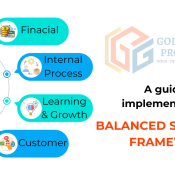
How To Set Team Goals In The Right Way – Part II
Create a feedback loop
Collaboration thrives on feedback. Providing strategic clarity to employees is a good start that helps them understand why their work matters and how they contribute to the company’s performance. But when you combine a top-down and bottom-up approach, ongoing communication is crucial for success.
“The main reason performance can fail and/or be unproductive is because there is no regular feedback-gathering culture in place throughout the organisation in between performance cycles.” – Says – Dr P V Siddharth CEO – of Golden Gate properties
40% of employees are actively disengaged when they receive little or no feedback. With regular chats about performance, you’ll help employees understand how they can make a positive impact on team goals and the company strategy.
How to improve your team goal-setting with feedback
Allow your team members to brainstorm and define goals on their own. After, you can provide feedback, and collaborate with your teams to refine their individual goals and ensure everything makes sense for the company’s long-term goals.
During team discussions about goals, here are some key questions to ask:
- Are our goals too ambitious or not?
- Have we assigned the right metrics to measure success?
- Do we have an action plan to hit milestones within the time frame?
- Do we have enough resources for each project?
- What could we do differently or better on any project?
- Should we adjust resource allocation to improve workflows or performance?
You don’t need to micromanage people or interfere in their daily work. With an open feedback loop, you can check in to get regular insights from teams about their progress toward team goals.
And in return, you can provide constructive feedback to eliminate confusion, reduce wasted time, and ensure everything (and everyone) stays on track.
Establish a habit of tracking progress
There is no point in setting team objectives if you don’t keep people accountable. By tracking your progress, you can gauge the impact of everyone’s work and identify where the team is getting stuck.
You don’t just track progress to keep people accountable—it also helps you to deliver results faster. If you don’t maintain a real-time overview of performance and progress across all projects, you won’t be able able to identify underperforming areas and adapt goals before it’s too late. And so, you risk wasting valuable resources and time.
How to improve your team goal-setting with tracking habits
It comes down to developing good organisational habits. Here are some ways you can encourage employees to be more diligent about tracking team goals:
- Delegate. You can assign responsibility to make it clear who should track performance on each project or team. Alternatively, giving teams autonomy to set and track their own goal empowers them to devise creative ways to deliver the best impact.
- Gamification. Review42 reports that 90% of employees feel more productive with gamification elements and 72% are inspired to work harder.
- Set up regular reviews. You can schedule weekly reports and check in with your team members to identify issues and help them if needed.

Reward success
All too often, milestones pass by without employees getting the thanks or credit they deserve from their leaders and team members. How can you expect people to do their best if they don’t feel valued?
69% of employees claim they would work harder if they felt recognised. As you drive individual employee engagement, it leads to more effective teamwork. Companies that use incentive programs report a 79% success rate in achieving team goals.
Consider the e-commerce chain Zappos. The company created a strategic employee recognition program with a peer-to-peer format, enabling employees to share rewards. Through low-cost, high-frequency rewards, and a collaborative ethos, Zappos helps teams reach their objectives and nurture a stronger company culture.
How to improve your team goal-setting by rewarding success
Set up an incentives program. Even with clarity about their role, many employees need a little more motivation to do their best work. A rewards program can help people do more for the team by pursuing individual goals.
Use apps to improve internal communication. Gartner reports that CEOs rate culture as their biggest concern when it comes to in-office and work-from-home environments. In an age where remote work is the norm, team-building is increasingly vital for employee engagement and retention.
Publicly recognise employee efforts. Even if you believe your goals are achievable, you must prove to your employees that the company cares about its people. Call out big wins on social media and internal chat groups, giving kudos to the individuals involved.
Strive for continuous improvement
As mentioned, an open feedback loop helps you achieve team goals. Two-way communication encourages a free flow of information from the top-down and bottom-up. This environment increases trust between team members and improves company-wide employee engagement.
Discussions around improving processes and behaviours are not awkward conversations about negative issues that happen once in a blue moon. Instead, there is a casual, ongoing conversation about continuous improvement.
A McKinsey client used this approach to reduce its product testing process time by 80%—saving the team ten weeks.
How to improve your team goal-setting with continuous improvement
When you encourage feedback from employees on your goal-setting approach, you can figure out how to drive more effective performance next time around.
For this to work, you must build a culture of continuous improvement, where everyone collaborates to evaluate the chosen approach and gives their opinions on what the company could eliminate or change to deliver better results.
This continuous improvement of your goal-setting approach thrives on active, open discussions between leaders and employees.
Here are some questions you can ask:
- Do employees think you give good feedback?
- When’s the best time to give feedback?
- What’s our biggest challenge as a team?
- How are they satisfied with our current processes?
- How can we improve the way our team works together?
- What are the biggest time wasters for you each week?
- Is there anything we could eliminate, automate, or outsource?
- Is there anything else you think we should be doing as a team?
Encouraging two-way communication and a focus on continuous improvement show employees that leaders value their opinions and care about making the company better for everyone. This collaboration keeps people engaged in their daily activities, helping them achieve their team goals.

Set and execute team goals with a strategy execution platform
Perfectly defined goals are no guarantee of success. It doesn’t matter how slick your presentation was at the company’s monthly slideshowfest. How can you expect your team members to effectively contribute to business performance if they don’t feel involved? A top-down approach to setting goals relies on leaders to lay out the company vision and filter it down through the ranks. On the other hand, a bottom-up approach allows your team members to tell you how they can contribute to the company’s success. Combining these methods makes everyone feel more involved and, as a result, more engaged.
Golden Gate can help you give your team clarity on the what, how, and why of their goals with structured plans in a centralised platform. Anyone on the team will be able to focus on efforts that drive progress while staying aligned with the company vision. And you will be able to have real-time visibility into what’s happening across your team.
Do you want to create strategic goals that engage employees and drive business performance? See how Golden Gate Properties can help you



